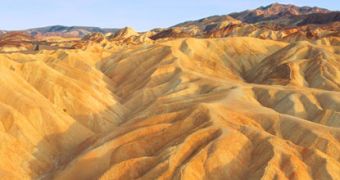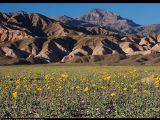With a length of 225 km (140 mi) and a width of 8-24 km (5-15 mi), the Death Valley, located in eastern California and western Nevada, is the driest, lowest and hottest land in North America. At Furnace Creek, the air temperature reached 57?C and that of the soil 94?C, with just 6?C under the water boiling point. This value was overcome just in Libya (58oC), still, the average summer temperature is the highest in the Death Valley, turning it into the hottest point of the planet.
The average annual rainfall amount is under 50 mm but some years are totally devoid of rainfall. This is the lowest ground in the Western Hemisphere, 86 m (290 ft) under the sea level at the place of a salt-water lake, Badwater. Mount Whitney is just 140 km (88 mi) away, 4,418 m (14,730 ft) tall, the highest in North America, except for Alaska.
In 1850, small amounts of gold were found at Salt Spring. Silver, copper and lead too were found in the area. Mining towns grew sprouted everywhere: Bullfrog, Greenwater, Rhyolite, and Skidoo. But after the deposits were gone, these cities remained empty.
In 1880, borax, a white crystalline compound used for making soap and other products was found in the Valley of Death. This discovery triggered the highest economical boom of the valley. Till 1888, crews made of 18 mules and 2 horses made the 270 km (170 mi) till the Mojave Town driving each two waggons loaded with borax, each 5 m (17 ft) long. Because of the unsupportable heat, both for men and animals, the transport was stopped from June to September.
In 1933, the Death Valley was declared national monument and extended gradually, having now 1.3 million hectares. In 1994, The Death Valley National Park was created, one of the largest in US.
The name is misleading, as hundreds of species inhabit or visit the area. Still, many are nocturnal, avoiding the heat of the midday. The largest native mammal is the desert bighorn sheep (Ovis canadensis nelsoni), inhabiting the surrounding mountains. Inside the valley live pumas, badgers, bats, bobcats, coyotes, swift foxes (Vulpes velox), skunks, porcupines, rabbits, poached mice, bewildered donkeys, lizards, snakes and tortoises. Birds to be found here are falcons, quails, ravens, vultures and others.
The most resistant animals of the valley are the poached mice: they can live all their life without drinking a droplet of water. They get the necessary water by burning the starch and fats extracted from the dry seeds they consume. Their urine is five times more concentrated than the humans'. During the day, these mice stay hidden inside their galleries, foraging during the night.
There are over 1,000 species of flowering plants living in the valley. There are even trees, like Yucca. Shoshone Indians inhabiting the valley used them both as food and for making tools.
From time to time, the valley blooms as the seeds waiting in the soil react to the right temperature and rainfall. But there can be several years without a flower.
During the winter between 2004 and 2005, the valley experienced the highest rainfall ever, thrice the average. Over 50 species bloomed, like larkspurs, lilacs, orchids, poppies, sunflowers, vervains and primroses.
There are four species of pupfish (Cyprinodon) in the Death Valley. During winter, these silvery creatures, 6 cm (2.5 in) long doze in the mud on the bottom of the springs and water ponds. During spring, they start spawning and the males turn shiny blue and defend their territories. But during the summer heat most of the water pools become dry and the desert pupfish die massively. The survivors live in a water which is extremely salty and with a temperature up to 44?C.

 14 DAY TRIAL //
14 DAY TRIAL // 
